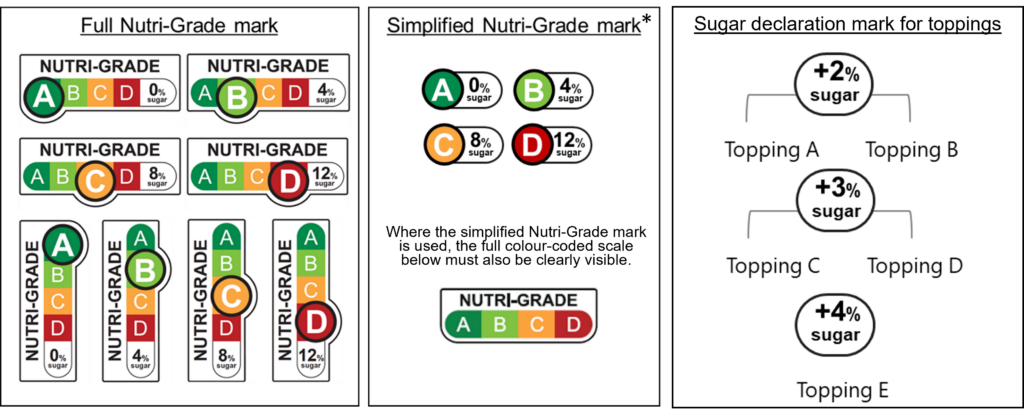If you were to grade how healthy your bubble tea order is from A to D, with A being the healthiest and D being the poorest possible grade, what would you give it?
It might get a D this time around. That’s because of the new Nutri-Grade labels that have been introduced.
In case you haven’t heard, by the end of this year, F&B establishments selling freshly made drinks like juices, smoothies, bubble tea, and coffee will have to show Nutri-Grade labels on their menus, both in-store and online.
In line with that, bubble tea shops across Singapore are rushing to tweak their drinks and menus, with the deadline for this mandatory nutrition labelling scheme coming closer.
Drink Toppings Must Be Labelled with Sugar Content
By 30 December 2023, food and beverage establishments offering freshly made drinks like juices, smoothies, bubble tea, and coffee must include Nutri-Grade labels on their menus.
The Nutri-Grade Label doesn’t only apply to the bubble tea base. It extends to the drink toppings as well.
This means that ingredients like pearls, jellies, ice cream, and whipped cream must feature a sugar content declaration.

This labelling requirement allows consumers to quickly identify which toppings have lower sugar content by checking the sugar declaration marks.

Nutri-Grade System Ranges from Grade A to D
If you’ve been buying bubble tea, you’d have spotted the Nutri-Grade labels in some outlets.
However, if you’re unfamiliar with the Nutri-Grade system, here’s a quick rundown.
It uses colour-coded grades, from A to D. Yep, you guessed it, D is where you’ll find the drinks packing the most sugar and saturated fat.
Meanwhile, A is the healthiest grade, signifying the least sugar and saturated fat content.

The interesting part is that drinks slapped with a D grade can’t be featured in advertisements—no fame for them.
According to The Straits Times, bubble tea shops like LiHo and Heytea are adjusting their drink recipes to bump them down from a D to a C grade.
Doing so will allow them to dodge the advertising restrictions, knowing that drinks in the D category can’t be promoted.
The Sunday Times has reached out to five bubble tea joints and discovered that only one bubble tea shop has put those mandatory nutrition labels on their menus.
How Does the Nutri-Grade Label at Bubble Tea Chains Work?
For beverage operators that provide customisation options for their drinks, such as bubble tea chains, customers are allowed to select sugar levels ranging from 0% to 100%.
A drink’s Nutri-Grade rating will be determined by its highest sugar content option, typically set at 100% sugar.
This approach aims to inform consumers about the potential maximum sugar intake in their beverage choices, promoting greater awareness and informed decision-making.
This response follows the feedback received from the industry in February, as stated by the Ministry of Health and Health Promotion Board.
In addition to providing transparency to consumers, regulatory authorities aspire to encourage the industry to reduce the upper limits of sugar and saturated fat content in their offerings.
The Nutri-Grade rating will be based on the default preparation method for operators that do not offer a range of customisation options for their drinks.
What is Nutri-Grade?
As part of Singapore’s fight against diabetes, the Ministry of Health (MOH) is rolling out mandatory nutrition labels and advertising restrictions for Nutri-Grade drinks.
These rules were kickstarted on 30 December 2022.
These steps are meant to help Singaporeans make healthier choices. They’re also extending these rules to more drinks by the end of 2023.
The aim is to reduce how much sugar people in Singapore consume.
Currently, pre-packaged sweet drinks already have labels showing their grade and sugar content.
Penalties for Establishments Not Complying with Nutri-Grade Labels
Failure to adhere to these regulations will be considered an offence and may result in penalties as follows:
For the first conviction, a fine not exceeding $1,000 may be imposed.
In the event of a second or subsequent conviction, the penalty may escalate to a fine not exceeding $2,000.
It’s important to note that individuals and smaller food businesses may be exempted from these penalties if specific conditions are met.
Would you be jailed for being half-naked in public? Well, the answer will shock you. Seriously. Watch this to the end and you'll understand:




